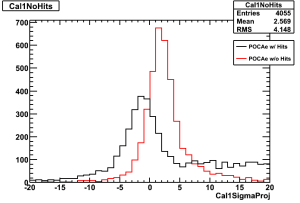Introduction
Eric suggested that looking at the The POCA distance (in sigma) from for tracks coming close to ACD tiles should give different distributions for tiles that are hit than for those that have no hit. Basically, this is saying that you expect tiles without hits to have track POCA that are more than 1 sigma from the tile active boundary. On the other hand hit tiles are expected to have POCA with negative sigma (distances inside the active tile). The cross-over from dominantly positive sigma POCAe to negative sigma should be a sharp feature which is present in the data and MC.
...
For a set of CrProtons generated from a modified HEAD1.1365 of GR, I grab the projected and propagated covariant distances of POCA from ACD tile elements. After selecting for well reconstructed tracks, I split POCA into two sets: those corresponding to hit tiles, and those corresponding to unhit tiles. I then also plot the plot the distance (in covariant sigma) from the tile active element and the fraction of the total number of events at a given covariant distance which correspond to (un)hit tiles.
...
| Code Block | ||
|---|---|---|
| ||
CalTrackAngle < 0.1; //Well Reconstructed Tracks mipsPmtA() < 0.001 && mipsPmtB() < 0.001; //Hit Tile Definition CalTrackAngle < 0.1; // Track Quality Selection |
Tile 22
Looking at an individual tile in the center of the ACD, the statistics are too limited to draw any real conclusions. However, these plots hint hit tiles tend to have POCA with negative covariant distances while the unhit POCA tend to have positive covariant distances (as expected).
...
Cal1 Raw Counts | Cal1 Ratio of Total Counts |
|---|---|
An interesting feature in the CalTrackAngle suggests that some non-negligible number of events have their cluster direction mis-aligned with the tracker track by 90 degrees. This comes from the fact that when a single crystal is hit in the calorimeter, the CAL axis is set to (0,0,0). When dotted into the TKR direction and taking the arccosine, you are left with 1.57...
CalTrackAngle |
|---|
|


